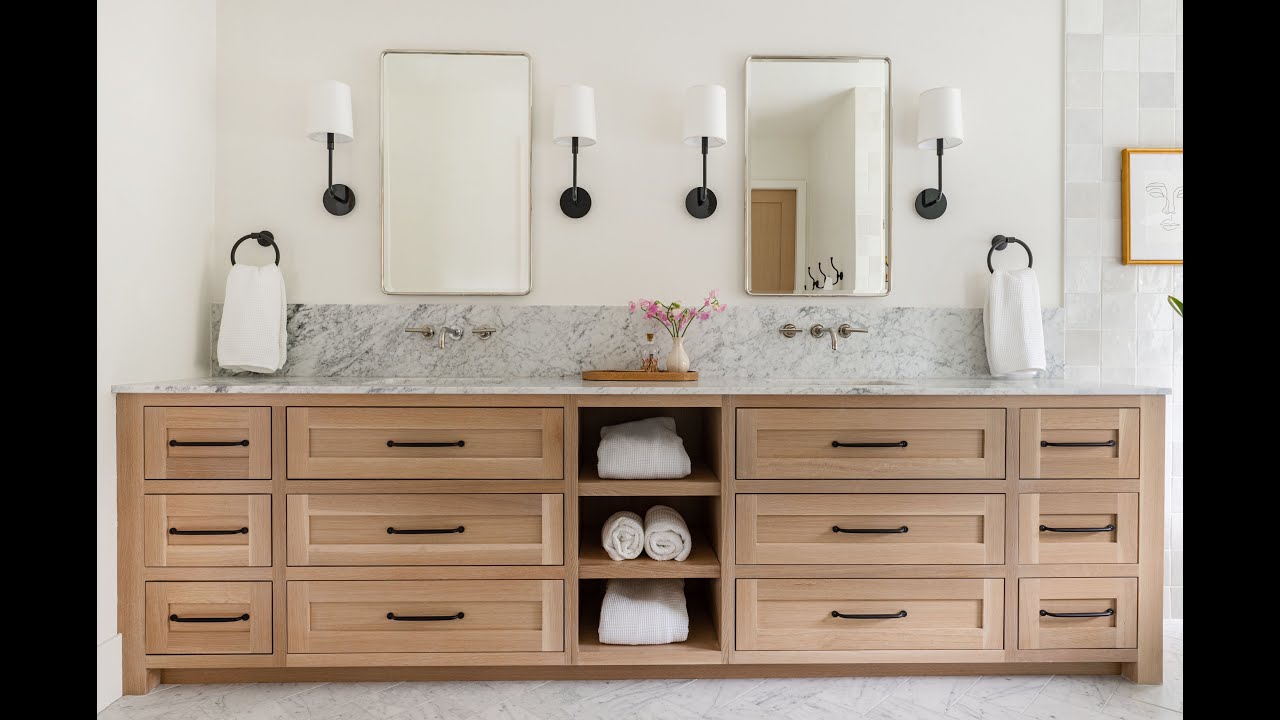Bathroom vanities play a crucial role in both the functionality and aesthetic of your bathroom. They serve as a focal point, providing storage, space, and style. Whether you're renovating an existing bathroom or designing a new one, choosing the right vanity can make all the difference. This guide will walk you through everything you need to know about bathroom vanities, helping you make informed decisions and create a bathroom that’s both beautiful and practical.
What are Bathroom Vanities?
A bathroom vanity is a piece of furniture that combines a sink, countertop, and storage space. It serves as a central point in the bathroom, housing plumbing and providing essential storage for toiletries, cleaning supplies, and other bathroom essentials.
Types of Bathroom Vanities
Freestanding Vanities
Freestanding vanities are versatile and come in a variety of styles, from traditional to modern. They are easy to install and can be moved if needed.
Wall-Mounted Vanities
Wall-mounted vanities, or floating vanities, are attached to the wall, giving the bathroom a modern and spacious look. They are ideal for small bathrooms as they free up floor space.
Corner Vanities
Perfect for small or oddly shaped bathrooms, corner vanities make use of otherwise wasted space, offering storage and functionality without taking up too much room.
Choosing the Right Material for Your Vanity
Solid Wood
Solid wood vanities are durable and add a touch of elegance to your bathroom. They can be expensive and require regular maintenance to prevent water damage.
MDF (Medium Density Fiberboard)
MDF is a cost-effective option that is resistant to moisture and less likely to warp than solid wood. However, it’s not as durable and can be damaged by prolonged exposure to water.
Plywood
Plywood offers a good balance between durability and cost. It is resistant to moisture and less prone to warping compared to solid wood.
Particleboard
Particleboard is the most affordable option, but it is also the least durable. It can swell and deteriorate when exposed to moisture.
Vanity Tops: Materials and Choices
Granite
Granite vanity tops are durable, resistant to scratches and heat, and add a luxurious feel to the bathroom.
Marble
Marble is elegant and beautiful but requires regular maintenance to prevent stains and scratches.
Quartz
Quartz is a durable and low-maintenance option that is resistant to stains and scratches. It comes in a variety of colors and patterns.
Laminate
Laminate is a budget-friendly option that comes in a wide range of colors and patterns, though it is less durable than natural stone.
Sink Types for Bathroom Vanities
Undermount Sinks
Undermount sinks are installed beneath the countertop, offering a seamless look and making cleaning easier.
Drop-In Sinks
Drop-in sinks have a rim that sits on top of the countertop. They are easy to install and available in a variety of styles.
Vessel Sinks
Vessel sinks sit on top of the countertop, creating a focal point in the bathroom. They come in various shapes and materials, adding a unique touch to your vanity.
Integrated Sinks
Integrated sinks are built into the countertop, offering a sleek and seamless look. They are easy to clean and maintain.
Storage Solutions for Vanities
Drawers
Drawers offer easy access to items and are ideal for storing smaller bathroom essentials like toiletries and makeup.
Cabinets
Cabinets provide ample storage space for larger items such as towels, cleaning supplies, and hairdryers.
Open Shelving
Open shelving adds a decorative element and is perfect for storing items you want to display, such as decorative towels or plants.
Vanity Lighting
Task Lighting
Task lighting is essential for activities like shaving or applying makeup. It should be bright and evenly distributed around the vanity area.
Ambient Lighting
Ambient lighting provides overall illumination and sets the mood of the bathroom. It can be achieved through ceiling lights or wall sconces.
Accent Lighting
Accent lighting highlights specific areas or features of the bathroom, adding depth and dimension to the space.
Installation Tips for Bathroom Vanities
Measuring Your Space
Measure the available space carefully, taking into account the location of plumbing and electrical outlets. Ensure there is enough room for the vanity, including any doors or drawers.
Choosing the Right Height
The standard height for bathroom vanities is around 32 inches, but this can vary based on personal preference and the height of users.
Plumbing Considerations
Ensure that the vanity is compatible with your existing plumbing. You may need to hire a plumber to adjust the pipes or install new ones.
Securing the Vanity
Secure the vanity to the wall using appropriate brackets and screws. This is especially important for wall-mounted vanities to ensure they are safely supported.
Trends in Bathroom Vanities
Floating Vanities
Floating vanities continue to be popular due to their modern look and space-saving design. They create an open and airy feel in the bathroom.
Double Vanities
Double vanities are ideal for shared bathrooms, offering two sinks and additional storage space. They provide convenience and functionality for multiple users.
Minimalist Designs
Minimalist designs focus on clean lines and simple forms. These vanities often feature handleless cabinets and monochromatic color schemes.
Eco-Friendly Materials
Eco-friendly materials like reclaimed wood and recycled glass are becoming more popular in bathroom vanities, reflecting a growing trend towards sustainability.
Custom vs. Pre-Made Vanities
Custom Vanities
Custom vanities are built to your specifications, allowing you to choose the exact size, style, and materials. They are ideal for unique spaces and personalized designs but can be expensive and time-consuming to produce.
Pre-Made Vanities
Pre-made vanities are available in a wide range of styles and sizes, making them a convenient and cost-effective option. They are ready to install and can be easily found in home improvement stores.
Budgeting for Your Vanity
Setting a Budget
Determine your budget before you start shopping. Consider the cost of the vanity itself, as well as any additional expenses such as installation, plumbing, and fixtures.
Cost-Saving Tips
Look for sales and discounts, consider purchasing a vanity with a built-in countertop and sink, and explore DIY options to save on installation costs.
Maintenance and Care for Your Vanity
Cleaning Tips
Use mild cleaning agents and a soft cloth to clean your vanity. Avoid harsh chemicals that can damage the surface. Regularly wipe down the countertop and sink to prevent water stains and buildup.
Preventing Damage
Seal natural stone countertops to prevent stains and scratches. Avoid placing hot items directly on the surface and use coasters for bottles and containers.
DIY Vanity Projects
Refinishing an Old Vanity
Give an old vanity a new lease on life by sanding, painting, or staining it. Replace the hardware and add new fixtures for an updated look.
Building a Vanity from Scratch
If you’re handy with tools, consider building your own vanity. This allows you to customize every aspect and create a truly unique piece.
Conclusion
Choosing the right bathroom vanity involves careful consideration of style, material, size, and functionality. By understanding the various options available and what suits your needs, you can create a bathroom space that is both stylish and practical. Whether you opt for a custom design or a pre-made model, a well-chosen vanity can transform your bathroom into a sanctuary of comfort and elegance.



